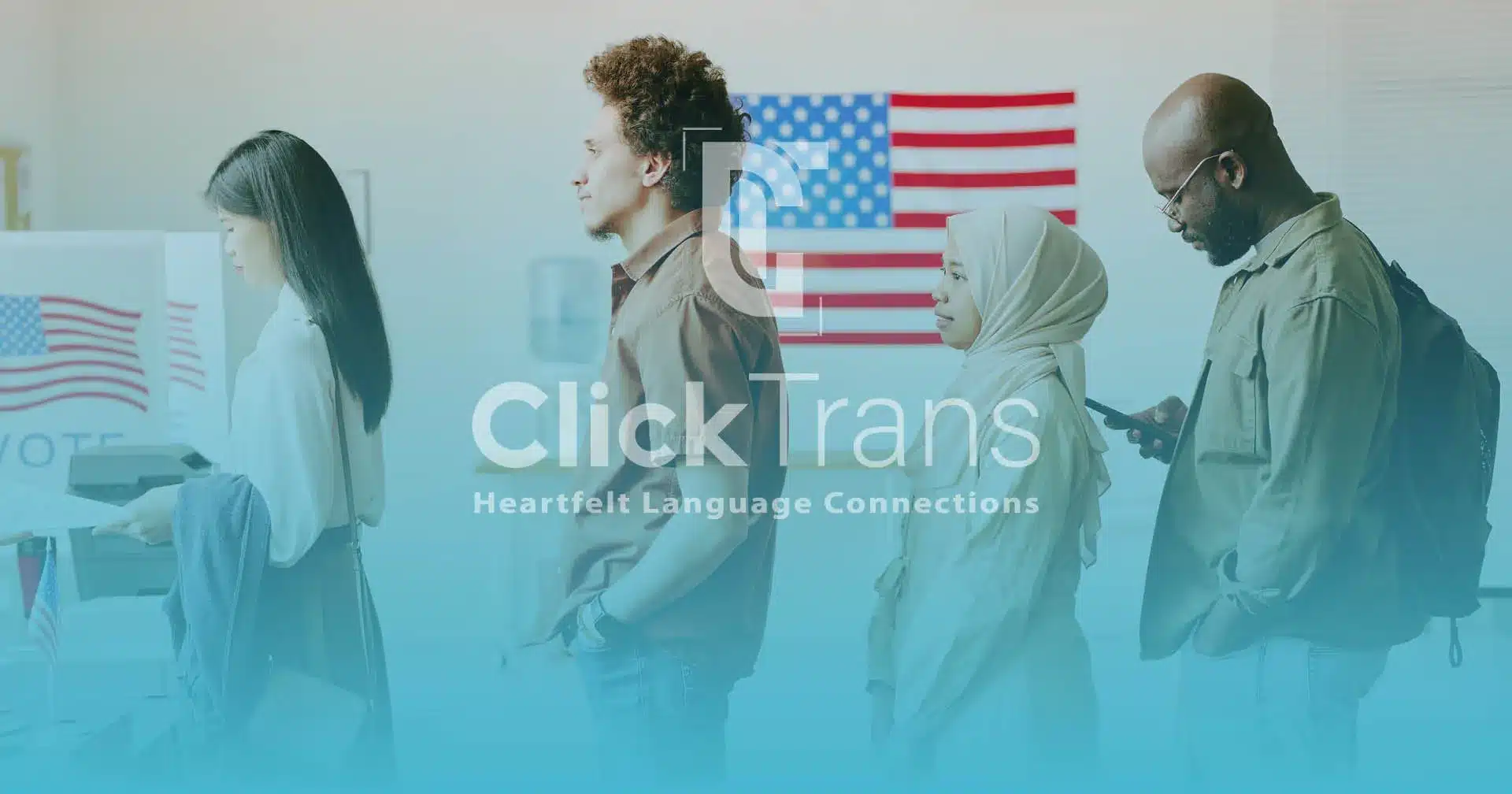Table of Contents
You’ve probably been hearing the word “immigrants” a lot lately.
With global conflicts and economic shifts, immigration is constantly in the spotlight. But behind the headlines are real people—seeking safety, opportunity, or simply a fresh start.
As of 2023, the U.S. is home to 47.8 million immigrants—the highest number in its history—making up 14.4% of the total population.
In this article, we’ll explore immigration into the United States by year, highlighting what the numbers reveal, how trends have shifted over time, and why language access is essential for integration today.
Immigration into the United States by Year: A Look at Key Statistics from 2000 to 2024
A two-decade timeline tells a powerful story. So, how much has immigration really changed since 2000? Let’s take a look at the number of immigrants per year in the U.S.
Green Cards Issued
| Year | New LPRs |
| 2000 | 841,002 |
| 2001 | 1,058,902 |
| 2002 | 1,059,356 |
| 2003 | 703,542 |
| 2004 | 957,883 |
| 2005 | 1,122,257 |
| 2006 | 1,266,129 |
| 2007 | 1,052,415 |
| 2008 | 1,107,126 |
| 2009 | 1,130,818 |
| 2010 | 1,042,625 |
| 2011 | 1,062,040 |
| 2012 | 1,031,631 |
| 2013 | 990,553 |
| 2014 | 1,016,518 |
| 2015 | 1,051,031 |
| 2016 | 1,183,505 |
| 2017 | 1,127,167 |
| 2018 | 1,096,611 |
| 2019 | 1,031,765 |
| 2020 | 707,362 |
| 2021 | 740,002 |
| 2022 | 1,018,349 |
| 2023 | 1,172,910 |
| 2024 (Q1 – Q3) | 980,100 |
Insights:
- Green card issuances increased by 39% between 2000 and 2024, reflecting the overall growth in legal permanent immigration.
- The number of new permanent residents peaked in the mid-2000s, declined sharply during the COVID-19 pandemic, and has been steadily rebounding since.
- Net migration more than tripled from approximately 800,000 in 2020 to around 3.3 million in 2023–2024, driven by policy shifts, humanitarian parole programs, and post-pandemic recovery efforts.
Immigration to the U.S. isn’t one-size-fits-all. Immigrants fall into several legal categories: naturalized citizens, lawful permanent residents (LPRs), temporary visa holders, and undocumented individuals.
As of 2023, an estimated 11.2 million immigrants were unauthorized, accounting for roughly 23% of all foreign-born residents source.
Undocumented immigrants remain a critical part of the immigration landscape, contributing to sectors like agriculture, construction, and service industries. While they often face limited access to public services and legal protections, their presence continues to shape key political, economic, and social conversations in the U.S.
Factors Influencing Immigration Trends in the USA
Why do people move to the U.S.? It’s a question with a dozen different answers, sometimes all at once.
Immigration into the United States by year doesn’t shift randomly. Trends are closely tied to what’s happening both in the U.S. and around the world. For example, when the U.S. economy is strong and industries are short on workers—like in agriculture or tech—you’ll often see a rise in employment-based visas like H-2A or H-1B. Labor demand pulls people in, and policies respond.
At the same time, global events push people to leave their home countries. We’ve seen it with the war in Syria, political collapse in Venezuela, and climate-driven droughts in Central America. These situations don’t just make headlines, they send people searching for safety, often ending up at the U.S. border as refugees or asylum seekers.
Policy shifts inside the U.S. also make a huge difference. Under the Trump administration, for example, immigration slowed down significantly due to tighter visa caps and stricter enforcement. Under Biden, we’ve seen an expansion of legal pathways, including humanitarian parole programs and higher refugee admissions.
And let’s not forget how COVID-19 disrupted everything. With embassies closed, borders shut, and programs paused, 2020 saw some of the lowest immigration numbers in recent history. But once the world reopened, the numbers bounced back fast.
So, if you’re wondering why immigration into the U.S. rises one year and drops the next, it’s rarely random. It’s usually the result of a mix of opportunity, crisis, policy, and timing, all unfolding on a global stage.
Who’s Moving to the U.S.?
Immigration isn’t just one door into the U.S. It’s several ones—from family sponsorships to work permits, student visas, and refugee programs, you can find them all moving to the USA. Believe it or not, the U.S. tracks all of that. Every green card issued or visa granted falls into a category, and the numbers over time reveal how priorities have shifted.
Looking at immigration into the United States by year, we see clear patterns in how each pathway evolved.
Between 2000 and 2023, family-based immigration remained the largest category by far. In most years, it accounted for about 65%–70% of all green cards issued. For example, in 2023, over 730,000 people were granted lawful permanent residence through family sponsorship.
Employment-based immigration usually makes up about 12%–17% of green card totals annually. That said, it spiked in some years, like 2022, when job market recovery and backlog clearance led to around 269,000 employment-based green cards, nearly double some previous years.
The refugee and asylum category fluctuates more. In 2016, over 84,000 refugees were admitted. Yet, under Trump administration, that number dropped significantly, falling below 12,000 in 2020. Under Biden, it gradually increased again, with a ceiling of 125,000 set for 2024.
And don’t forget student visas, they’re technically temporary, but a big part of the picture. In 2015, the U.S. issued over 644,000 F-1 visas. That number dropped during the pandemic (just 357,000 in 2020) but has since bounced back to nearly 600,000 in 2023.
So yes, immigration is many things, but the U.S. immigration statistics behind each path shows how the U.S. continues to balance family ties, economic needs, humanitarian responsibilities, and global talent.
Beyond visa categories, immigrants contribute significantly to the U.S. economy. They play vital roles in sectors like healthcare, construction, hospitality, and technology. In 2023, foreign-born workers made up approximately 18.6% of the total U.S. labor force, helping fill critical gaps in both high-skilled and essential service jobs.
The Countries Behind U.S. Immigration Trends
Ever wonder where most immigrants to the U.S. are coming from? Don’t think too much, it’s changed more than you might think.
Back in the early 2000s, Mexico topped the list. In 2001, over 200,000 Mexican nationals became lawful permanent residents (green card holders). For years, Mexico remained the leading country of origin, thanks largely to family reunification and long-established migration networks.
But things started shifting. By the 2010s, while Mexico still led, other countries like China, India, and the Philippines began climbing the ranks, especially through employment- and family-based visas.
For instance, in 2016, China and India each accounted for over 75,000 green card recipients, putting them just behind Mexico.
Fast forward to recent years, and the diversity only grows. In 2022, the top five countries for new green card holders were:
- Mexico = ~102,000
- India = ~65,000
- China = ~44,000
- Cuba = ~39,000
- Dominican Republic = ~33,000
In 2023, new countries climbed the list. Haiti, Afghanistan, and Ukraine saw notable increases, largely due to humanitarian programs and refugee admissions.
What’s clear is: while some countries stay steady on the list, others rise in response to global events, policy changes, or shifts in visa demand. It’s a dynamic mix that reflects how the U.S. immigration system balances family ties, workforce needs, and humanitarian response.
California, Texas, Florida, and New York continue to host the largest immigrant populations, with Los Angeles and New York City leading the urban concentration.
What the Data Means for the Future of U.S. Immigration
If the last two decades tell us anything, it’s this: U.S. immigration isn’t slowing down… It’s shifting.
The data on immigration into the United States by year shows fewer immigrants coming from just one country, and more arriving from all over—India, China, Cuba, Venezuela, Haiti, and beyond. That kind of diversity isn’t random. It reflects how U.S. immigration policies adapt (or don’t) to what’s happening in the world.
Policy is a big part of the story here. Whether it’s raising the refugee cap, rolling out humanitarian parole programs, or updating work visa rules, each administration leaves its mark.
One presidency might open doors to certain groups, while another tightens entry or narrows legal paths altogether. That push-and-pull is something we’ve seen time and again, and it’s likely to continue.
Looking ahead, we’ll probably see more targeted policy shifts, especially around labour shortages, skilled migration, and border enforcement. Tech and healthcare industries are already pushing for expanded work visas, while debates over asylum processing and border control remain hot topics in Congress.
Here’s something else the data hints at: immigration is becoming increasingly tied to language and integration needs. As new populations arrive from more diverse linguistic backgrounds, access to translation, interpretation, and culturally relevant services will be crucial, not just for individuals, but for schools, hospitals, and local governments.
The takeaway? Immigration to the U.S. isn’t just shaped by global events. It’s also deeply shaped by who’s in office, what policies they prioritize, and how flexible the system is in a rapidly changing world.
Language Needs of Immigrant Populations Over Time
As immigration patterns shift, so do the languages spoken across the U.S., and with them, the need for clear, accessible communication.
Think about it like that: when someone arrives in a new country, applying for a visa, enrolling a child in school, or understanding their rights as a refugee all depend on being able to understand and be understood.
That’s where ClickTrans comes in. ClickTrans isn’t just a translation service—we’re a partner in helping institutions bridge language gaps effectively. From certified translations for immigration documents (like green card applications or USCIS paperwork), ClickTrans helps ensure that language is never a barrier to essential services.
Language access is just one part of the broader assimilation problems faced by immigrants, including cultural adaptation, access to healthcare and education, and navigating unfamiliar systems.
As immigration becomes more diverse and multilingual, this kind of support becomes even more critical, not just for new arrivals, but for the organizations and institutions trying to serve them.
In short? Language support isn’t a side note. In fact, it’s a key part of a functioning, inclusive immigration system.
Looking for accurate, certified, and fast translations?
Contact us today and request a free quote.
Conclusion
U.S. immigration statistics have never stood still—and the numbers from 2000 to 2024 tell a powerful story of how the system, the people, and the reasons for coming have evolved.
By examining immigration into the United States by year, we gain a deeper understanding of shifting policies, global events, and changing demographics.
But one thing hasn’t changed: people still need to be seen, heard, and understood. As immigrant communities become more linguistically diverse, the need for accurate, accessible language services only grows.
Translation services like ClickTrans help ensure language isn’t a barrier to starting fresh. At the end of the day, understanding each other is where every journey begins.
Frequently Asked Questions
How do changing immigration policies affect language needs?
When policies shift (like refugee caps or work visa expansions), different populations arrive, bringing new linguistic and cultural needs that public institutions must respond to.
What role do translation services play beyond immigration paperwork?
They support schools, hospitals, courts, and social services in communicating effectively with immigrant communities who may not speak English fluently.
How does ClickTrans support institutions, not just individuals?
ClickTrans offers scalable language support for organizations, like schools, clinics, and local agencies, helping them serve immigrant communities more effectively.
Can language services impact how well immigrants integrate into U.S. society?
Definitely. Clear communication builds trust and access. Whether it's understanding legal rights or filling out school forms, language support makes integration smoother.








